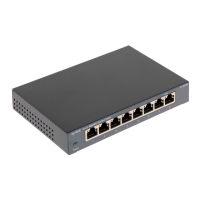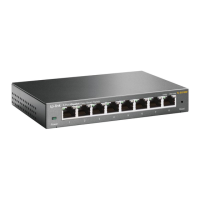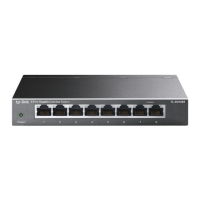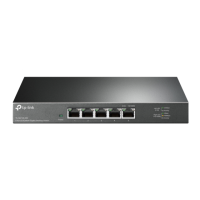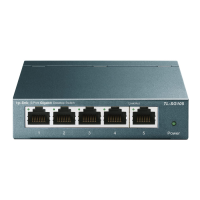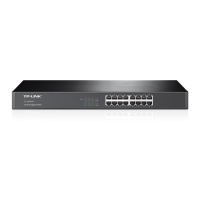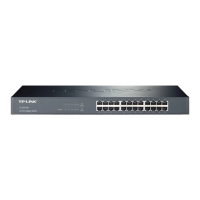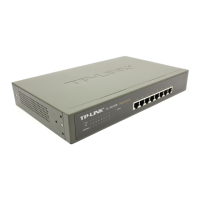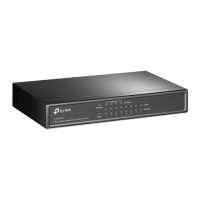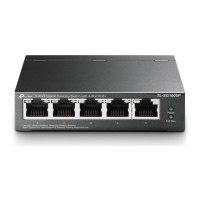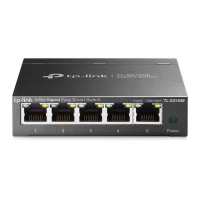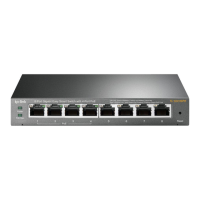Do you have a question about the TP-Link TL-SG108PE and is the answer not in the manual?
Features of the Easy Smart Switch, including traffic monitoring, VLAN, QoS, and PoE.
Step-by-step guide on how to access the switch's web interface for configuration.
How to view and specify device description and other system information.
Steps to configure the switch's IP address using DHCP or manually.
Procedure to modify the administrator's username and password.
How to save and load switch configurations to manage settings.
Steps to configure port status, speed, duplex mode, and flow control.
How to configure 802.1Q VLAN tagging and PVID settings.
Guide to configuring QoS modes like Port Based, 802.1P, and DSCP.
Steps to control ingress and egress traffic rates for ports.
Steps to configure PoE settings, including system power limits and port settings.
Features of the Easy Smart Switch, including traffic monitoring, VLAN, QoS, and PoE.
Step-by-step guide on how to access the switch's web interface for configuration.
How to view and specify device description and other system information.
Steps to configure the switch's IP address using DHCP or manually.
Procedure to modify the administrator's username and password.
How to save and load switch configurations to manage settings.
Steps to configure port status, speed, duplex mode, and flow control.
How to configure 802.1Q VLAN tagging and PVID settings.
Guide to configuring QoS modes like Port Based, 802.1P, and DSCP.
Steps to control ingress and egress traffic rates for ports.
Steps to configure PoE settings, including system power limits and port settings.
| Switch type | Managed |
|---|---|
| Switch layer | L2 |
| Quality of Service (QoS) support | Yes |
| Installed SFP modules quantity | 0 |
| Basic switching RJ-45 Ethernet ports type | Gigabit Ethernet (10/100/1000) |
| Basic switching RJ-45 Ethernet ports quantity | 8 |
| 10G support | No |
| Number of VLANs | 32 |
| Networking standards | IEEE 802.1Q, IEEE 802.1p, IEEE 802.3ab, IEEE 802.3i, IEEE 802.3u, IEEE 802.3x |
| Virtual LAN features | Port-based VLAN |
| Cable types supported | Cat3, Cat4, Cat5, Cat5e, Cat6 |
| Total Power over Ethernet (PoE) budget | 64 W |
| Power over Ethernet (PoE) ports quantity | 4 |
| Power over Ethernet (PoE) power per port | 15.4 W |
| Jumbo frames | 15000 |
| Forwarding rate | 11.9 Mpps |
| MAC address table | 4000 entries |
| Packet buffer memory | 1.5 MB |
| Power source | DC |
| Input current | 1.25 A |
| Input voltage | 48 V |
| Power consumption (max) | 65.2 W |
| Certification | FCC, CE, RoHS |
| Product color | Black |
| Rack mounting | - |
| LED indicators | Activity, Link, PoE, Power, Speed, Status |
| Package type | Box |
| Package depth | 196 mm |
| Package width | 131 mm |
| Package height | 121 mm |
| Package weight | 890 g |
| Cables included | AC |
| Heat dissipation | 256.19 BTU/h |
| Storage temperature (T-T) | -40 - 70 °C |
| Operating temperature (T-T) | 0 - 40 °C |
| Storage relative humidity (H-H) | 5 - 95 % |
| Operating relative humidity (H-H) | 10 - 90 % |
| Harmonized System (HS) code | 85176990 |
| Depth | 101 mm |
|---|---|
| Width | 158 mm |
| Height | 25 mm |
